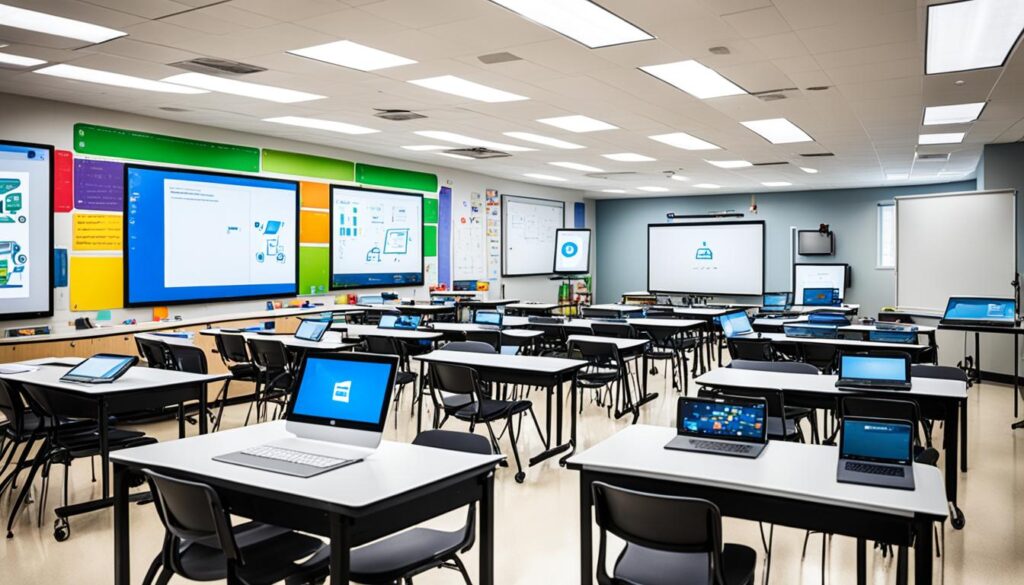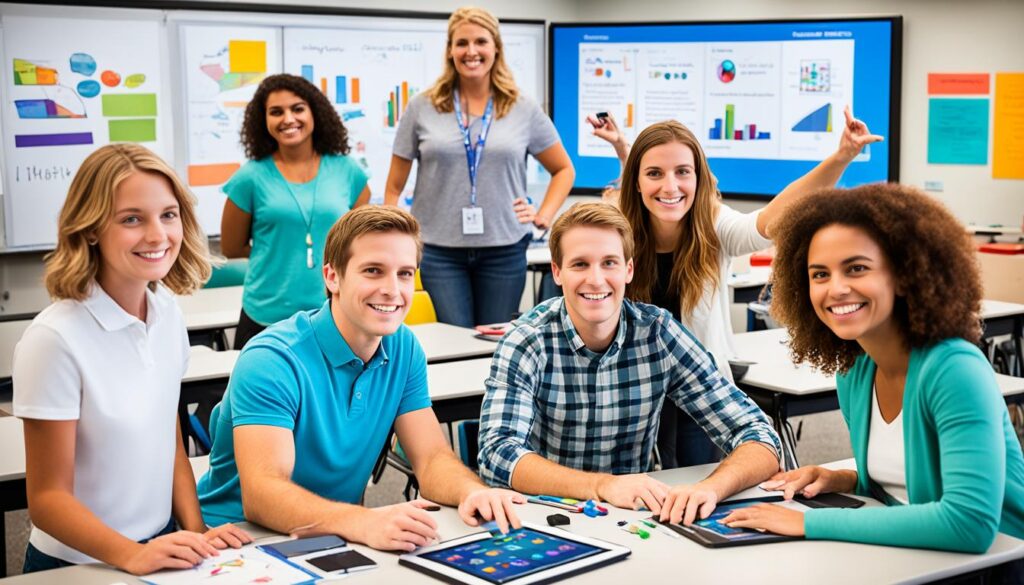Technology is key in today’s classrooms, making learning more personal and engaging. It uses gadgets like smartphones, computers, and tablets. This mix of devices boosts student interest and tailors lessons to fit each student’s needs.
Key Takeaways:
- Technology in education enables engaging and personalized learning experiences.
- Integrating technology involves using devices such as smartphones, computers, and tablets.
- Technology enhances student engagement and facilitates differentiated instruction.
- Incorporating technology in the classroom caters to the unique needs of individual students.
What Does Technology Integration Mean in Education?
Technology integration in education means combining tech tools and resources in the classroom. Its goal is to make learning more fun and interactive for students. It uses technology to boost student involvement and customize teaching for each student’s needs.
It includes more than just computers and tablets. It also uses various digital tools and platforms. These tools make learning happen anywhere, not just in the classroom.
Teachers use online tools, apps, and multimedia to make learning dynamic. This approach creates a modern, tech-friendly learning space for students.
Technology integration in education aims to blend traditional and digital teaching methods. It opens new ways for students to learn, work with peers, and develop problem-solving skills.
Key to technology integration is personalized learning. Technology helps adapt teaching for different student learning styles. This tailored approach makes learning more effective and enjoyable for each student.
Additionally, technology in education helps students become digitally literate. This is crucial in today’s tech-heavy world. It teaches them how to find and evaluate information, work with others, and create digital content.
In summary, technology integration changes classrooms into advanced, engaging spaces. It helps teachers teach better and prepares students for the digital future. This way, it makes education more effective and enjoyable for everyone.
How to Integrate Technology in the Classroom
Using technology in the classroom doesn’t mean giving every student a tablet or laptop. It can be done with basic tech tools and educational apps. This approach enhances how students learn, encourages them to work on their own or together, and makes learning interactive.
A great way to do this is by making interactive presentations. Use tools like PowerPoint to add videos or images. These features grab students’ interest, making lessons more fun and interesting.
Educational apps such as Kahoot can also help. They let you create fun quizzes and games that students love. Plus, they give teachers instant feedback to see how well students understand the material.
Don’t forget, internet-based homework can also be a tech-friendly idea. Set tasks that require online research or interactive work. This way, students learn more about the subject and pick up essential skills for the online world.
Facilitating Independent and Collaborative Work
Technology in the classroom supports working alone and in groups. Students can team up on projects and share ideas using apps or online tools. This helps them learn to work together and improves their communication skills.
Online grading systems also play a big role. They make it easier for teachers, students, and parents to stay in the loop. Everyone can check grades and feedback easily. This system makes education more transparent and keeps everyone accountable.
By using simple tech tools and apps, teachers can transform the learning atmosphere. It becomes engaging and tailored to students’ needs. Technology boosts student involvement and teaches skills like independent thinking, cooperation, and digital literacy, all of which are key for success today.

Strategies of Implementation for Age Groups
When using technology in the classroom, it’s key to think about students’ ages. Matches technology use to what each age group needs. This helps teachers make learning more fun and effective for everyone.
Elementary Schools: Building Fundamental Skills
Technology is great for young kids to learn the basics. They can use apps and online tools for reading and math. Games like ABCmouse and Prodigy are fun and teach important skills.
There are also videos and e-books for science and history. Sites like Nearpod and Kahoot make learning more interactive and engaging. They let students take quizzes and join classroom activities.
Middle School: Developing Life Skills and Research Capabilities
Middle schoolers can benefit a lot from technology. They learn to work in teams using Google Docs. They also get good at finding reliable info online.
Tools like Evernote help them keep their research organized. This boosts critical thinking skills. It’s useful for school and life beyond.
High School: College and Career Preparation
High school tech focuses on getting ready for the next step. Students learn software for future jobs. They also use platforms like Canvas for their classes.
Working in groups improves their communication. Plus, VR and AR make learning more exciting in various subjects. Technology is a big help for high schoolers’ success.
Implementing Technology for All Age Groups
Implementing tech in classes needs careful planning. Teachers need to learn how to use it. Ongoing support makes sure things go smoothly.
It’s important to always check if technology is helping students learn. Listening to students and their families helps teachers improve. With the right tools, tech can make learning exciting at any age.
Why is it Important to Integrate Technology in the Classroom
Integrating technology makes learning more fun and effective. It helps teachers engage students better. They can use cool apps and digital tools. This creates personalized learning experiences.
Increased Student Engagement
Introducing tech in the classroom changes how kids learn. Interactive resources grab their attention. Things like educational apps, virtual reality, and smart boards make learning fun. This boosts their interest and motivation.
Crucial Digital Literacy Skills
In our digital world, knowing how to use tech is a must. Technology in the classroom helps students learn vital skills. They learn to find good information online. Plus, they get better at working with others online.
Personalized Instruction and Differentiated Learning
Everyone learns differently. Technology helps teachers meet each student’s needs. Teachers can use online tools to keep an eye on progress. This way, they can give feedback and help each student do their best.
Using tech in class does bring challenges, like too much screen time. But, the good of using technology is bigger. It helps students prepare for a future where tech is key. Proper use of tech can make learning better for everyone.

A Brief History of Technology in Education
Technology in education has a deep-rooted history, changing the way we learn. In the 1980s, computers started entering classrooms. This change ushered in a new educational era.
The 1990s brought the internet to everyone. It gave teachers and students new ways to find and share information. The introduction of search engines and email made learning easier and more connected.
In Britain’s 1988 Education Reform Act, ICT became a must in state schools. This move highlighted the essential role of digital tech in education. It pushed for tools that could enhance learning in the digital age.
By the early 2000s, whiteboards and handhelds were common. These tools made learning more interactive. Students could actively participate in their education in fun ways.
Today, technology is key in almost all US classrooms. 97% have a computer and internet access. This shows how deeply tech is woven into our educational fabric.
Technology in education has made huge leaps over the years. It gets better to meet students’ and teachers’ needs. Today, it enables more personal learning and teaches important digital skills.
What are the Benefits of Using Technology in Education
Technology in education has many benefits. It helps students learn better and prepare for the future. Here are some key advantages of using technology in the classroom.
Enhanced Student Engagement
Technology makes learning fun and interactive. It grabs students’ attention and gets them involved. Educators can use tech tools to make lessons exciting and relevant.
Development of Crucial Digital Skills
Digital skills are a must for success today. Technology in education helps students learn these skills. They can practice using software, researching online, and staying safe on the internet.
Facilitated Communication and Collaboration
Tech makes it easy for students to connect and work together. They can share ideas and collaborate on projects online. This improves their communication and teamwork skills.
Personalized Instruction and Differentiated Learning
Technology allows for teaching that fits each student’s needs. With online resources, teachers can create personalized learning paths. This helps students learn at their own pace.
| Benefits of Using Technology in Education | Keywords |
|---|---|
| Enhanced Student Engagement | student engagement |
| Development of Crucial Digital Skills | digital skills |
| Facilitated Communication and Collaboration | communication, collaboration |
| Personalized Instruction and Differentiated Learning | personalized instruction, differentiated learning |

Technology changes education for the better. It makes learning fun and prepares students for a tech-driven future.
Potential Challenges of Digital Learning
Introducing tech into education helps a lot, but it also brings issues. Teachers face problems setting up new tech or finding tools that fit how they teach. This can make it hard to use tech well in class.
Not having enough devices or bad internet can stop students from using tech to learn. Schools need to solve these problems. They must make sure every student can use technology for their education.
Getting distracted by digital devices is also a big deal. It can be tough for students to stay focused. They need to learn when to use tech for school and when to take a break.
Teachers need to make sure adding tech doesn’t make their teaching worse. They must balance technology with what works best for teaching. Trying out different tech tools can help find what works for their lessons.
“Using tech in teaching needs a plan to face challenges and mix it smoothly with learning.”
Learning to use tech well is important for teachers. They need regular help to use tech tools right. Workshops and meetings can help teachers learn new ways to teach with tech.
Keeping students safe while using tech is crucial. Teachers must protect students’ private info and follow privacy rules. Having clear rules to keep data safe is a must.
Dealing with these challenges is key to successful tech integration in education. By solving tech setup, managing distractions, keeping a good tech / non-tech balance, and respecting privacy, teachers can run better classes. They can make learning more fun and effective for students.
How to Optimize the Use of Technology in Education
To get the most from technology in education, teachers need to use it well. They should keep up with new tech in education. This makes sure technology works smoothly in teaching, making learning better for students.
Stay Updated with Educational Technology Trends and Tools
Technology always gets better, with new tools and trends showing up in education. Teachers can improve by going to workshops and conferences. These let them learn about new tools and the best ways to use them with students.
Assess Teaching Methods and Curriculum
To use technology well, teachers need to look at how they teach and what they teach. This lets them see where tech can help students learn more. They need to think about how students learn and what tools will help the most.
Provide Ongoing Support and Training
Having the right support and training is vital for using technology in class. Teachers need to keep learning how to use tech better. They can also get help from coaches or mentors. This makes sure tech is used to its full advantage.
Invest in Reliable Technology Infrastructure
Good technology in schools means having the best tech and tools. This includes fast internet, enough devices for students, and the right software. With a strong tech setup, teaching with tech is smoother and more effective.
Using the right strategies, teachers can make learning fun and personal for students with technology. Technology keeps getting better. So, teachers need to keep learning how to use it for student success.
Conclusion
Technology in education has changed the game, offering big wins for both students and their teachers. It jazzes up learning by making it more fun and interactive through gadgets. This means students are better prepared for life in the digital world. They learn digital skills early on, which is super important for their future.
But like all good things, there are hurdles. Teachers need to take steps to avoid tech distractions and smoothly blend it into their lessons. They do this by sharing tips, giving out resources, and continually learning themselves.
At the end of the day, tech in schools is preparing students for a fast-changing future. It gives them the skills they need to navigate in tomorrow’s world. And, it makes learning more exciting, pushing students to do their best.
FAQ
What is technology integration in education?
In simple terms, technology integration means using tech to make learning better for students. This can include things like online classes and digital grading.
How can technology be integrated in the classroom?
Technology becomes a part of the classroom through several tools. For example, teachers use PowerPoints and fun apps like Kahoot. These tools make learning more interesting and allow for different kinds of study.
How can technology be implemented for different age groups?
Technology use changes as kids get older. In elementary school, it helps build basic skills and makes learning fun. Middle school kids use tech to learn about life skills and do more in-depth research. In high school, tech helps students prepare for college and jobs by teaching them about apps and teamwork.
What are the benefits of using technology in education?
There are many upsides to using tech in learning. Students get more interested, learn how to use digital tools better, and can study in ways that fit them. Tech also makes it easier for students to work together, whether they’re in the same room or far apart.
What are the potential challenges of implementing technology in the classroom?
Introducing tech into classes can be tricky for teachers. They might find it hard to pick the right tools or to use them in their teaching. Not having enough devices or internet can also cause problems. Other concerns include too much screen time and making sure it doesn’t take over other important school work.
How can the use of technology in education be optimized?
There are ways to make sure tech helps students the most. Teachers should keep learning about new tech and how to use it well. They can also update their teaching ways to fit the tech. Helping teachers learn and having good tech tools are key things to do.




















